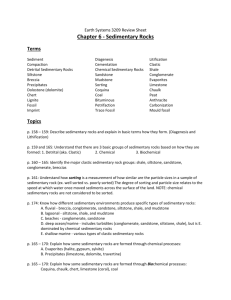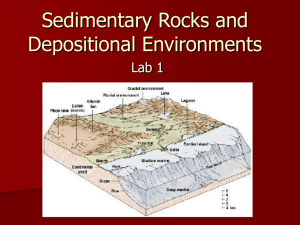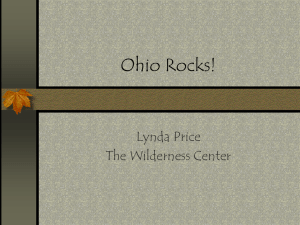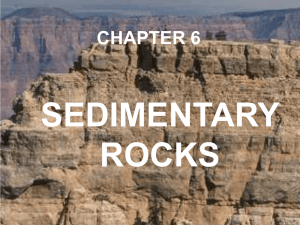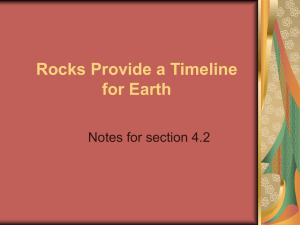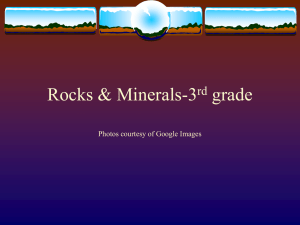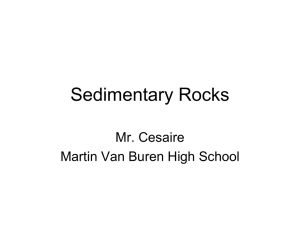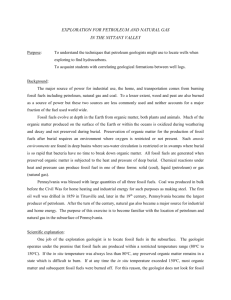Sedimentary rocks
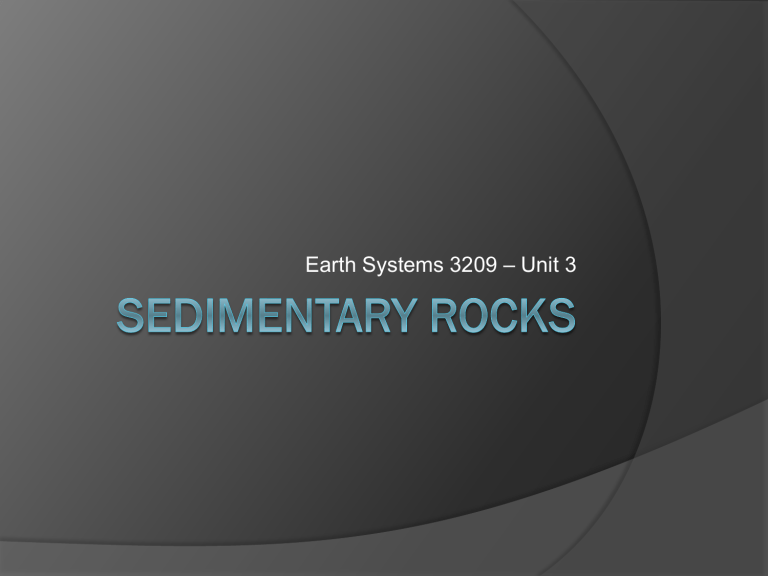
Earth Systems 3209 – Unit 3
The Rock Cycle
Why study sedimentary rocks? Economic use, fossils and earths history.
5% of Earths crust is sedimentary rock.
75% of Earths surface is sedimentary rock .
Sedimentary Processes
Formed from sediments of pre-existing rocks
(i.e. metamorphic, igneous or sedimentary).
Created by the processes of WEATHERING
(i.e. break-up) and EROSION (i.e. removal and transportation).
Weathering (Two Types: Chemical and
Mechanical)
Erosion (Agents: water, ice, and wind)
Aided by gravity, sediments travel to bodies of water where they are deposited (i.e. come to rest). Over geological time, sediments transform into sedimentary rock.
Sedimentary Processes
Sediments are formed into rock by the process of
LITHIFICATION, which includes two subprocesses:
Compaction : pressure from the burial of sediments solidifies material into rock. This results in reduced porosity and permeability. (Note: effective with small grain sizes)
Cementation : minerals precipitate out (i.e. crystallize) of circulating ground water, which cements sediments together (SiO
2
, CaCO
3,
FeO
3
)
Cementation and Compaction
Cement
Sediment Particles
Can anyone give examples of sedimentary rocks?
Breccia
Coal
Sandstone
Conglomerate
Shale Siltstone
Rock Salt Gypsum
Limestone
Coquina
Dolomite Chaulk
CLASSES of Sedimentary Rocks
Clastic (also called detrital):
(e.g., shale, siltstone, sandstone, conglomerate, breccia)
Formed from mechanical weathering
Classified based on particle size (and particle shape)
Chemical:
Evaporites (e.g., rock salt, gypsum, sylvite)
Precipitates (e.g., compact limestone, travertine, dolomite, chert)
Chemical weathering – dissolving of chemicals
Biochemical
(e.g., coquina, chert, coal, coral limestone, chaulk)
Accumulation of living material – i.e. organic remains
Clastic Characteristics:
Clastic rocks are classified based on grain size (e.g., shale - clay, siltstone - silt, sandstone - sand) with the exception of Breccia (angular gravel particles), and conglomerate (rounded gravel particles), which are classified based on grain shape.
Grain Shape (rounded, angular)
Sorting (well sorted, poorly sorted)
DOES NOT APPLY TO
CHEMICAL OR BIOCHEMICAL, BUT IT DOES APPLY TO CLASTICS!
Cementation (e.g., siliceous, calcareous, or iron oxide)
Porosity (pore space - % of open space or holes)
Permeability (communication or interconnectiveness between pore space – Darcy’s )
What can we tell from grain size/shape?
Grain size decreases with decreasing current velocity
(i.e. decreasing energy) . In general, larger grain sizes are closer to the source of weathering. Smaller grain sizes are further from the source of weathering.
The roundness of grains increases with increasing distance from the source of weathering . Angular grains have not traveled far from the source.
High Velocity Low Velocity
Breccia, Conglomerate Sandstone Siltstone Shale
HORRIZONTAL SORTING (COARSE TO FINE FROM LEFT TO RIGHT)
Clastic Depositional Environments AND
Rocks
Fluvial (Rivers/streams) – Conglomerate, Breccia,
Sandstone, Siltstone, Shale
Lagoonal/Bays – Siltstone, Shale
Beaches – Conglomerate, Sandstone
Deep Marine – Involves turbidites (Conglomerate,
Sandstone, Siltstone, Shale), but is dominated by chemical sedimentary rocks.
Shallow Marine – Conglomerate, Sandstone,
Siltstone, Shale
Fluvial
Beach
Fluvial
Shallow
Marine
Turbidites
Deep marine sedimentary rocks resulting from underwater avalanches. Characterised by graded bedding - fining upwards sequences of conglomerate at the bottom, followed by sandstone, siltstone and shale.
Chemical Sedimentary Rocks
Chemical:
1) Evaporites (e.g., halite, gypsum, sylvite)
NOTE THAT THE ABOVE ARE THE RESULT OF THE
EVAPORATION OF WATER.
2) Precipitates (e.g., compact limestone, travertine, dolomite, nodular chert)
DUE TO CHANGES IN ENVIRONMENTAL CONIDITONS
(E.G., TEMPERATURE CHANGE, CHEMICAL CHANGE,
CONCENTRATION CHANGE).
Chemical weathering – dissolving of chemicals
Chemical Sedimentary rocks
Chemical Depositional Environments:
1. Shallow Marine (e.g., gypsum, halite, sylvite, limestone and dolomite)
2. Deep Marine (e.g., limestone, dolomite and nodular chert)
3. Cave - Stalactites and stalagmites
Stalactites are icicle-like pendants that hang from the ceiling. Water seeps through cracks in the ceiling of the cave.
Stalagmites form from the floor.
The precipitated limestone that makes up stalactites and stalagmites is called travertine.
Stalactites and Stalagmites
Biochemical Sedimentary Rocks
Coquina – forms from the build-up, compaction, and cementation of shells from dead organisms (mostly on beaches).
Chaulk – forms from the accumulation, compaction, and cementation of microscopic marine organisms such as formaminifera (i.e. deep marine)
Chert – forms from the accumulation of microscopic marine organisms, such as radiolaria and diatoms, that form a very hard rock consisting of microcrystalline silica. Examples of chert include jasper, flint, and agate (i.e. deep marine)
Coral limestone – accumulations of coral can be compacted and cemented into coral limestone (i.e. shallow marine)
Coal – formed form the accumulation of plant material, which is buried and chemically altered over millions of years.
What are corals?
Corals are examples of organisms that are capable of creating large quantities of marine limestone from their shells and external skeletons which are composed of calcium carbonate.
The Formation of Coal - Swamps
There are 4 stages of coal formation:
1)
2)
3)
4)
Peat – earliest stage of plant accumulation. Contains large amounts of volatiles. (PEAT IS NOT A ROCK).
(VOLATILES – E.G., CARBON DIOXIDE, WATER).
Lignite – decreased levels of volatiles. It is classified as a sedimentary rock.
Bituminous – higher grade of coal than lignite. It is classified as a sedimentary rock.
Anthracite – final stage of coal formation. It is classified as a metamorphic rock due to heat, pressure, and hot chemical fluids. It burns cleaner than other stages of coal due to less volatiles present. Small amount available world-wide.
Increasing
Grade
Four Stages of Coal Formation
Peat Lignite Bituminous Anthracite
Biochemical Sedimentary Rocks
-
-
-
-
Depositional Environments
Swamp – Coal
Shallow Marine – Coquina, Limestone (Coral)
Beach – Coquina
Deep Marine – Chaulk, Chert
Think about the concept of systems. How do biochemical sedimentary rocks and coral represent a dynamic interaction of the spheres?
Core Lab 3 – Sedimentary Rocks
Review:
Concept Map for rocks
Next class – Metamorphic Rocks
